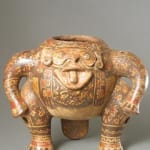Guanacaste-Nicoya Tlaloc Effigy Tripod Vessel, 500 CE - 1000 CE
Terracotta
8
PF.5745
Further images
-
(View a larger image of thumbnail 1
)

-
(View a larger image of thumbnail 2
)

-
(View a larger image of thumbnail 3
)

-
(View a larger image of thumbnail 4
)

-
(View a larger image of thumbnail 5
)

-
(View a larger image of thumbnail 6
)

-
(View a larger image of thumbnail 7
)

-
(View a larger image of thumbnail 8
)

-
(View a larger image of thumbnail 9
)

Known throughout Mesoamerica by many names, Tlaloc, the great god of water, was probably one of the oldest gods worshiped as a result of the importance of rain for crop...
Known throughout Mesoamerica by many names, Tlaloc, the great god of water, was probably one of the oldest gods worshiped as a result of the importance of rain for crop production. Tlaloc was not a creator God, but one created by other Gods. Although a beneficent god, Tlaloc certainly had the power to unleash floods, lightning and drought when angry. To please him children were sacrificed to him as well as prisoners dressed in his image. Legend has it that the more babies and children cried, the more Tlaloc was pleased. During the sacrifices, the tears of the screaming children were seen as representations of falling rain; the more the children cried, the better the rain season. Tlaloc can easily be identified by his characteristic mask, giving him the impression of eyeglasses and a mustache.
Created in the jungles of Costa Rica, this vessel reveals how widespread the worship of the Aztec god Tlaloc was. The Guanacaste-Nicoya region of Costa Rica was itself a composite style, merging influences from the north and south. The round, spherical body of this vessel stands on Tlaloc’s two legs in the front and a wide of sorts in the back. The god’s arms curve around and rest on his legs. Polychrome paints decorate the exterior, specifically rich oranges, reds, black and cream. The great rain god greets us with a menacing gaze. His mouth is open, holding his tongue out at us. Circular, abstract bands embellish the ends of his limbs. Certainly, this vessel must have been cherished in its time, not only for its stupendous artistry, but also for the powerful deity it represents. Perhaps it played a central role in elaborate ceremonies enacted to appease the mighty Tlaloc. Yet this vessel represents something greater, it is a link to a time of superstition and magic, a time when everything was uncertain and the gods demanded sacrifices.
Created in the jungles of Costa Rica, this vessel reveals how widespread the worship of the Aztec god Tlaloc was. The Guanacaste-Nicoya region of Costa Rica was itself a composite style, merging influences from the north and south. The round, spherical body of this vessel stands on Tlaloc’s two legs in the front and a wide of sorts in the back. The god’s arms curve around and rest on his legs. Polychrome paints decorate the exterior, specifically rich oranges, reds, black and cream. The great rain god greets us with a menacing gaze. His mouth is open, holding his tongue out at us. Circular, abstract bands embellish the ends of his limbs. Certainly, this vessel must have been cherished in its time, not only for its stupendous artistry, but also for the powerful deity it represents. Perhaps it played a central role in elaborate ceremonies enacted to appease the mighty Tlaloc. Yet this vessel represents something greater, it is a link to a time of superstition and magic, a time when everything was uncertain and the gods demanded sacrifices.








